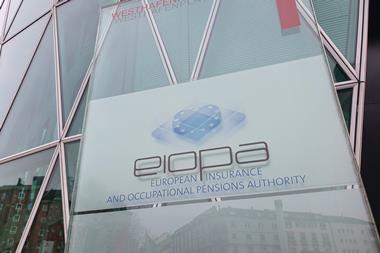The EU pension fund regulator has proposed collecting look-through data on IORPs’ investments in UCITs and derivative information as part of a move to strengthen its capacity to analyse emerging risks in the occupational pensions sector.
In a consultation document, EIOPA said this capacity was “currently limited as it lacks crucial data in a number of areas”.
Important data gaps had been identified, it added, namely in the area of derivatives and look-through information.
The regulator is also proposing to amend current reporting requests to include cashflow information to calculate comparable and market-consistent values of IORPs’ defined benefit liabilities (or more information on discount rates); cross-border data by host country ”to get an accurate picture of the cross-border relationships”; and four-digit reporting of NACE codes to allow for better assessment of environmental, social and governance (ESG) risks.
NACE refers to the EU’s economic activity-based classification system (NACE) for complex projects – NACE codes are used by the EU sustainability taxonomy.
EIOPA’s consultation, which runs until 18 July, concerns a ‘Decision’ adopted by EIOPA’s board of supervisors in 2018 about regular requests for occupational pension information from national supervisors.
‘Proportionate revision’
In the consultation document, EIOPA said its proposals would lead to crucial improvements by addressing data gaps, correcting certain flaws, and aligning taxonomies between reporting frameworks.
It said it was proposing a “proportionate revision” of the current requests of information, “levelling the information available at the different National Competent Authorities (NCAs) across the EU”.
“Indeed, many of the requested data are already reported to some NCAs which shows the usefulness for supervisory purposes,” it added. “However, not all information is reported to all NCAs.”
Regarding flaws in the 2018 Decision, EIOPA said a “quick fix” had addressed certain errors but that another revision, including amending reporting templates, was required to address all concerns identified.
As concerns the alignment of taxonomies, EIOPA said the alignment, “where relevant”, of terminology, definitions, data dictionaries and modelling between IORPs and Solvency II was best practice in line with the strategy on supervisory data in EU financial services, and that this would ultimately lead to lower costs.
“With the upcoming review of Solvency II and the planned amendments to some of the templates which are overlapping with the IORPs templates (e.g. list of assets, look-through, derivatives), it is important to continue maintaining this alignment,” it said.
EIOPA is proposing to implement the amendments under consultation at the end of 2024 “to allow for adequate implementation time and as such mitigate the costs involved”.
Options for liability reporting
When it comes to data on technical provisions EIOPA has suggested options for an amendment. The problem these are aiming to solve is that “the current data received does not allow for a proper monitoring of the underlying trends explaining variations to liability nor does allow [sic] having a comparable basis considering the different methods and discount rates used to calculate the liabilities”.
It said the data requested by EIOPA for the IORP stress test was more fit for purpose.
The options it has suggested are:
- requesting the annual reporting of cashflow data in a new template, similar to parts of the cashflow template requested by the stress tests;
- similar to the first option but with data aggregated by cash inflow and outflows;
- further elaboration of discount rates instead of reporting cashflows
Read the digital edition of IPE’s latest magazine














No comments yet